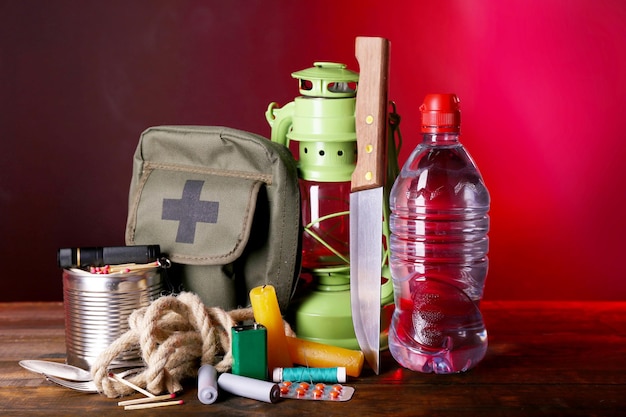Hurricane Season: New Emergency Preparedness Guidelines Released

Anúncios
As hurricane season approaches, new emergency preparedness guidelines have been released to help residents in affected areas prepare and stay safe, emphasizing proactive measures and updated safety protocols.
As hurricane season looms, it’s crucial to ensure you’re adequately prepared. Recently, updated emergency preparedness: new guidelines released ahead of hurricane season, offering vital steps to protect yourself, your family, and your property.
Anúncios
Understanding the Updated Hurricane Preparedness Guidelines
The updated hurricane preparedness guidelines are designed to provide individuals and communities with the most effective strategies for mitigating the risks associated with these powerful storms. These guidelines incorporate the latest scientific understanding of hurricane behavior and emphasize proactive measures to reduce potential damage and ensure safety.
These guidelines cover a wide range of topics, from creating an emergency kit to understanding evacuation routes. By familiarizing yourself with these recommendations, you can significantly improve your ability to weather a hurricane and recover more quickly afterward.
Anúncios
Key Changes in the New Guidelines
Several key changes have been introduced in the latest hurricane preparedness guidelines. These updates reflect advancements in forecasting technology and lessons learned from recent hurricane events.
- Enhanced Evacuation Planning: The guidelines now provide more detailed information on evacuation routes and shelters, along with recommendations for individuals with specific needs, such as those with disabilities or medical conditions.
- Improved Communication Strategies: The guidelines emphasize the importance of staying informed through multiple channels, including local news, social media, and emergency alert systems.
- Updated Home Protection Measures: The guidelines offer updated recommendations for protecting your home from hurricane damage, including advice on securing windows, reinforcing roofs, and trimming trees.
In conclusion, the updated hurricane preparedness guidelines offer crucial information and strategies for mitigating the risks associated with these powerful storms. By staying informed and taking proactive measures, individuals and communities can significantly improve their ability to weather a hurricane and recover more quickly afterward.

Creating a Comprehensive Emergency Kit
One of the most critical aspects of hurricane preparedness is assembling a comprehensive emergency kit. This kit should contain all the essential supplies you and your family will need to survive for several days without access to outside assistance.
A well-stocked emergency kit can make a significant difference in your comfort and safety during and after a hurricane.
Essential Items for Your Emergency Kit
When creating your emergency kit, be sure to include the following essential items:
- Water: At least one gallon per person per day for several days, for drinking and sanitation.
- Food: Non-perishable food supplies, such as canned goods, energy bars, and dried fruits.
- First Aid Kit: A well-stocked first aid kit with bandages, antiseptic wipes, pain relievers, and any personal medications.
In summary, creating a comprehensive emergency kit is essential for hurricane preparedness. By including water, non-perishable food, a first aid kit, and other essential items, you can ensure you and your family have the supplies you need to survive for several days without outside assistance.
Understanding Hurricane Risks and Vulnerabilities
To effectively prepare for hurricanes, it’s important to understand the specific risks and vulnerabilities in your area. This includes knowing your flood zone, understanding the potential for storm surge, and assessing the structural integrity of your home.
By understanding these risks, you can take targeted measures to protect yourself and your property.

Assessing Your Property’s Vulnerability
Take the time to assess your property’s vulnerability to hurricane damage. This includes inspecting your roof, windows, and doors for any signs of weakness or disrepair.
Additionally, consider the landscaping around your home. Trim any trees or branches that could potentially fall on your house during a storm.
Understanding hurricane risks and vulnerabilities is crucial for effective preparedness. By knowing your flood zone, assessing your property’s vulnerability, and understanding the potential for storm surge, you can take targeted measures to protect yourself and your property.
Developing a Family Emergency Plan
A well-defined family emergency plan is essential for ensuring everyone knows what to do in the event of a hurricane. This plan should cover evacuation routes, communication strategies, and meeting points.
Having a plan in place can reduce stress and confusion during a hurricane, allowing your family to respond more effectively.
Key Components of a Family Emergency Plan
Your family emergency plan should include the following key components:
- Evacuation Route: Identify the safest and most efficient evacuation route from your home to a designated shelter or safe location.
- Communication Strategy: Establish a communication strategy to ensure everyone can stay in touch during and after the storm, even if cell service is disrupted.
- Meeting Point: Designate a meeting point away from your home in case family members become separated.
In essence, developing a family emergency plan is crucial for hurricane preparedness. This plan should cover evacuation routes, communication strategies, and meeting points, ensuring everyone knows what to do in the event of a hurricane.
Protecting Your Home from Hurricane Damage
Taking proactive measures to protect your home from hurricane damage can significantly reduce the potential for costly repairs and ensure your safety during the storm.
These measures range from securing windows and doors to reinforcing your roof and trimming trees.
Effective Home Protection Strategies
Consider implementing the following strategies to protect your home from hurricane damage:
- Secure Windows and Doors: Install hurricane shutters or board up windows and doors with plywood to prevent breakage from flying debris.
- Reinforce Your Roof: Strengthen your roof by adding hurricane straps or clips to secure the rafters to the walls.
- Trim Trees: Trim any trees or branches that could potentially fall on your house during a storm.
- Clear Gutters and Downspouts: Clear out gutters and downspouts to prevent water buildup and potential damage to your roof and foundation.
Ultimately, protecting your home from hurricane damage is a proactive step that can significantly reduce the potential for costly repairs and ensure your safety during the storm. Secure windows and doors, reinforce your roof, trim trees, and take other preventive measures to safeguard your property.
Staying Informed During a Hurricane
Staying informed during a hurricane is critical for making informed decisions and staying safe. This involves monitoring local news, weather alerts, and emergency broadcasts.
Access to accurate and timely information can help you avoid dangerous situations and take appropriate action.
Reliable Sources of Information
Rely on the following reliable sources of information during a hurricane:
- Local News Outlets: Follow local news channels and radio stations for up-to-date information on the storm’s progress and potential impact.
- National Weather Service: Monitor the National Weather Service website and social media channels for official weather alerts and forecasts.
- Emergency Alert Systems: Sign up for local emergency alert systems to receive notifications on your phone or other devices.
Staying informed during a hurricane is critical for making informed decisions and staying safe. Monitor local news, weather alerts, and emergency broadcasts to stay up-to-date on the storm’s progress and potential impact.
Recovering After a Hurricane
The recovery period after a hurricane can be challenging, but being prepared and knowing what to expect can make the process smoother.
This includes understanding how to assess damage, file insurance claims, and access resources for assistance.
Key Steps in Post-Hurricane Recovery
Take the following key steps in the post-hurricane recovery process:
- Assess Damage: Carefully assess the damage to your home and property, taking photos and documenting everything for insurance purposes.
- File Insurance Claims: Contact your insurance company as soon as possible to file a claim for any damages covered under your policy.
- Access Resources for Assistance: Reach out to local, state, and federal agencies, as well as non-profit organizations, for assistance with housing, food, and other essential needs.
Recovering after a hurricane can be challenging, but being prepared and knowing what to expect can make the process smoother. Assess damage, file insurance claims, and access resources for assistance to rebuild your life and community.
| Key Point | Brief Description |
|---|---|
| ⚠️ Emergency Kit | Assemble a kit with water, food, first aid, and essentials for several days. |
| 🏡 Home Protection | Secure windows, reinforce the roof, and trim trees to minimize damage. |
| 📡 Stay Informed | Monitor local news and weather alerts for timely updates. |
| evac-icon Evacuation Plan | Know evacuation routes and shelter locations for safe relocation. |
FAQ
▼
Your emergency kit should include water, non-perishable food, a first-aid kit, flashlight, batteries, a manual can opener, and any personal medications. Consider adding items like a whistle, dust mask, and moist towelettes.
▼
Protect your home by securing windows and doors with shutters or plywood, reinforcing your roof, trimming trees, and clearing gutters. Consider elevating appliances and furniture if you live in a flood-prone area.
▼
During a hurricane, rely on local news outlets, the National Weather Service, and emergency alert systems. These sources provide up-to-date information on the storm’s progress and potential impact on your area.
▼
If an evacuation is ordered, follow the designated evacuation routes and head to a safe location, such as a shelter or a friend’s or family member’s home outside the affected area. Bring your emergency kit with you.
▼
After a hurricane, you can help your community by volunteering your time, donating to relief organizations, and supporting local businesses as they rebuild. Stay informed and follow guidance from local authorities.
Conclusion
Preparing for hurricane season is a crucial responsibility for those living in at-risk areas. By taking proactive steps to understand the new emergency preparedness: new guidelines released ahead of hurricane season, create an emergency kit, develop a family plan, and protect your home, you can significantly enhance your safety and resilience in the face of these powerful storms. Remember to stay informed and support your community throughout the recovery process.